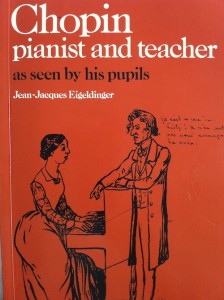It seems to me that you don’t dare to express yourself as you feel. Be bolder, let yourself go more. Imagine you’re at the Conservatoire, listening to the most beautiful performance in the world. Make yourself want to hear it, and then you’ll hear yourself playing it right here. . . I see that timidity and lack of self-confidence form a kind of armor around you, but through this armor I perceive something else that you don’t always dare to express, and so you deprive us all. . .Be bold and confident in your own powers and strength.
So instructed Chopin to one of his favorite students, Emile von Gretsch, a member of high society who also happened to be a gifted and hardworking amateur pianist. When I first read this advice a hundred-and seventy-years later, I felt as though it could be tailored to me as a student of classical piano music. Chopin’s words to Emile are one of many gems in Chopin: Pianist and Teacher, as Seen by His Pupils. The author, Jean-Jacques Eigeldinger, is a Swiss musicologist and a retired professor of Geneva University.
The core of this well-researched and tightly-written book is a compendium of advice from Chopin as recalled by his students. The author divides Chopin’s wisdom into two sections, first Chopin’s general comments on basic technique and musical style, secondly the composer’s advice for interpreting a selected list of his works. In the interpretation of works section, I was delighted to find the Nocturne in E-flat major. The advice that the bass chords should sound like a chorus of guitars was revelatory to me, and I often imagine, to my benefit, guitars strumming in the bass when I play the music.
What makes this book of particular interest to readers of this blog is that the vast majority of Chopin’s pupils were, what we would term today, students of adult piano lessons. The number of professionals that he taught during his lifetime amounted, Eigeldinger estimates, to about twenty. The rest were amateurs with a passion for the piano. Admittedly, most were aristocrats, for Chopin charged a whopping twenty gold francs for a lesson, then sufficient to support daily expenses for a bourgeois family. Yet as a result of Chopin’s focus on amateurs, the advice in this book feels tailor-made for students of adult piano lessons.
I should note that not all adult piano students rave about Chopin. In fact, one of my fellow performing members of The New York Piano Society, a retired doctor, has a strict no-Chopin policy because he believes the Romantic composer is overplayed. True enough, but not a sufficient reason in my mind to deprieve myself of Chopin’s delicious preludes and nocturnes. For those students of adult piano lessons equally enamoured of Chopin, this book serves as an engaging read and a valuable reference.





0 Comments